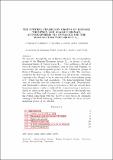Files in this item
The further chameleon groups of Richard Thompson and Graham Higman : automorphisms via dynamics for the Higman groups Gn,r
Item metadata
| dc.contributor.author | Bleak, Collin | |
| dc.contributor.author | Cameron, Peter | |
| dc.contributor.author | Maissel, Yonah | |
| dc.contributor.author | Navas, Andrés | |
| dc.contributor.author | Olukoya, Feyishayo | |
| dc.date.accessioned | 2023-01-05T11:30:06Z | |
| dc.date.available | 2023-01-05T11:30:06Z | |
| dc.date.issued | 2022-04-22 | |
| dc.identifier | 243106576 | |
| dc.identifier | 2aacb8ea-f770-45da-928e-6d20dac33f49 | |
| dc.identifier.citation | Bleak , C , Cameron , P , Maissel , Y , Navas , A & Olukoya , F 2022 , ' The further chameleon groups of Richard Thompson and Graham Higman : automorphisms via dynamics for the Higman groups G n,r ' , Memoirs of the American Mathematical Society . < https://arxiv.org/abs/1605.09302 > | en |
| dc.identifier.issn | 0065-9266 | |
| dc.identifier.other | ArXiv: http://arxiv.org/abs/1605.09302v1 | |
| dc.identifier.uri | https://hdl.handle.net/10023/26680 | |
| dc.description | Funding: The first and second authors wish to acknowledge support from EPSRC grant EP/R032866/1 received during the editing process of this article. The fourth author would like to thank St. Andrews University for its hospitality during the Workshop on the Extended Family of Thompson’s Groups in 2014, and acknowledges the support of DySYRF (Anillo Project 1103, CONICYT) and Fondecyt’s project 1120131. The fifth author was partly supported by Leverhulme Trust Research Project Grant RPG-2017-159. | en |
| dc.description.abstract | We characterise the automorphism groups of the Higman groups Gn,r as groups of specific homeomorphisms of Cantor spaces Cn,r, through the use of Rubin's theorem. This continues a thread of research begun by Brin, and extended later by Brin and Guzmán: to characterise the automorphism groups of the 'Chameleon groups of Richard Thompson,' as Brin referred to them in 1996. The work here completes the first stage of that twenty-year-old program, containing (amongst other things) a characterisation of the automorphism group of V, which was the 'last chameleon.' As it happens, the homeomorphisms which arise naturally fit into the framework of Grigorchuk, Nekrashevich, and Suschanskiī's rational group of transducers, and exhibit fascinating connections with the theory of reset words for automata (arising in the Road Colouring Problem), while also appearing to offer insight into the nature of Brin and Guzmán's exotic automorphisms. | |
| dc.format.extent | 44 | |
| dc.format.extent | 749337 | |
| dc.language.iso | eng | |
| dc.relation.ispartof | Memoirs of the American Mathematical Society | en |
| dc.subject | Automorphism groups | en |
| dc.subject | Higman-Thompson groups | en |
| dc.subject | Chameleon groups | en |
| dc.subject | Rational group | en |
| dc.subject | Transducers | en |
| dc.subject | QA Mathematics | en |
| dc.subject | T-NDAS | en |
| dc.subject | BDQ | en |
| dc.subject | AC | en |
| dc.subject | MCP | en |
| dc.subject.lcc | QA | en |
| dc.title | The further chameleon groups of Richard Thompson and Graham Higman : automorphisms via dynamics for the Higman groups Gn,r | en |
| dc.type | Journal article | en |
| dc.contributor.sponsor | EPSRC | en |
| dc.contributor.institution | University of St Andrews. Pure Mathematics | en |
| dc.contributor.institution | University of St Andrews. Centre for Interdisciplinary Research in Computational Algebra | en |
| dc.description.status | Peer reviewed | en |
| dc.identifier.url | https://www.ams.org/cgi-bin/mstrack/accepted_papers/memo | en |
| dc.identifier.url | https://arxiv.org/abs/1605.09302 | en |
| dc.identifier.grantnumber | EP/R032866/1 | en |
This item appears in the following Collection(s)
Items in the St Andrews Research Repository are protected by copyright, with all rights reserved, unless otherwise indicated.

